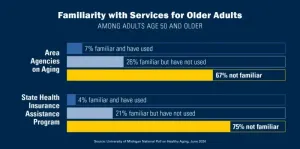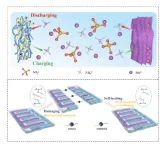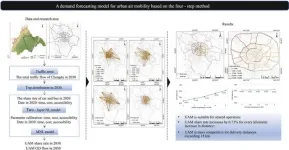(Press-News.org) Older Americans may be missing out on a wide range of programs and services that could help them meet their needs or assist their aging loved ones, a new poll suggests.
The new findings from the National Poll on Healthy Aging, based at the University of Michigan, show most older adults don’t know about important public resources for older adults and their caregivers, either by name or general description.
The poll asked more than 4,000 adults over age 50 about their awareness and use of Area Agencies on Aging (AAAs), State Health Insurance Assistance Programs (SHIPs) for navigating Medicare, and their options for long term services and supports (LTSS), should they need them.
And only a small minority – less than 10% – said they had used these programs or knew a lot about them.
Since many of these programs go by different names at the local, regional or state level, the poll questions also included a general description.
Only 7% of respondents said they had used their AAA’s services, 4% said they had used a SHIP program’s services, and 3% said they knew a lot about LTSS options.
One in four U.S. adults age 50 and older (26%) were familiar with AAAs but had never used them, and 21% were familiar with SHIPs but had never used them.
But 67% of U.S. residents over age 50 weren’t familiar with AAAs, 75% weren’t aware of SHIPs, and 88% said they didn’t know anything, or knew very little, about their options for receiving LTSS if they needed them.
Poll respondents who were age 65 or older were more likely to be familiar with AAAs and SHIPs than those age 50 to 64, whether or not they had used the service. In all, 37% of those over 65 were familiar with AAAs, versus 29% of those age 50 to 65; for SHIPs, 31% of the older group said they were familiar, compared with 20% of the younger group.
But even among those over age 65 who were aware of these services, most had not used them. In all, only 9% of people over 65 had used their AAA’s services and only 5% had used SHIP services.
Michigan-specific findings
An analysis of Michigan-specific data from the poll shows that older Michiganders were more likely than their peers in the rest of the country to say they had heard of AAAs. The same was true for the state SHIP program, which the poll asked about by its name in the state, the Michigan Medicare Assistance Program.
Still, 55% of older Michiganders didn’t know about AAAs and 68% didn’t know about SHIP or MMAP for Medicare assistance.
The percentage who had actually used either service was similar in Michigan and nationwide.
Need for more awareness
Overall, the poll’s findings suggest a need for more efforts to build awareness about how older adults and their caregivers can find and access the services available to them. Many such programs are supported by state and federal tax dollars.
“Our poll points to a gap between the resources that exist and what older adults know is available to help them navigate their choices as they age or care for others,” said Erica Solway, Ph.D., M.S.W., M.P.H., the deputy director of the poll, which is based at the U-M Institute for Healthcare Policy and Innovation.
“Even if people don’t know these programs by name, it appears that states and nonprofits could do more to spread general awareness of websites and hotlines that can act as gateways to the full array of services each person might qualify for,” she added. “Often, members of the public seek these services for themselves or others in times of crisis. So, the message that support is available, and how to find it when it’s needed, could help people plan.”
The National Poll on Healthy Aging is supported by AARP and Michigan Medicine, U-M’s academic medical center. The Michigan Poll on Healthy Aging, which gathers Michigan-specific data, is supported by the Michigan Health Endowment Fund.
Finding services for older adults
Solway points to the federal government’s Eldercare Locater site, eldercare.acl.gov, which prompts visitors to enter their ZIP code or to call 1-800-677-1116 to start the process of finding services for older adults and caregivers in their community.
Another gateway service for finding programs for older adults and people with disabilities is the Benefits Checkup website run by the National Council on Aging, a nonprofit organization, at benefitscheckup.org.
There’s also a federal Disability Information Access Line (DIAL), which helps people with disabilities get connected to information about local community resources that support independent living by entering their ZIP code on the DIAL website or calling 1-888-677-1199.
There is also information available from state aging agencies and county or municipal governments, including local senior centers.
Navigating the array of services and programs available can be daunting, which makes awareness efforts about how to get help even more important, the poll team notes.
Some services have income-based, geographic, or demographic eligibility limits to receive them. Others are available to any older adult or caregiver for older adults, and many also serve younger people with disabilities.
More about SHIPs, AAAs and LTSS programs
The SHIP program is open to anyone who qualifies for Medicare because of age or disability, and offers help at the local level. SHIP is independent of any private insurance company or brokers involved in Medicare Advantage plans.
Each state has its own SHIP program; the national website www.shiphelp.org and phone number (1-877-839-2675) makes it easy to find them.
SHIPs can be very helpful to anyone who wants to review their Medicare options ahead of or during the annual Open Enrollment period that runs from October 15 through December 7. Such a review can help determine if switching plans within Medicare Advantage, or between Medicare Advantage and traditional Medicare, would save on out-of-pocket costs and premiums. People can also seek SHIP services any time during the year, for instance when approaching Medicare enrollment age or anticipating retiring from a job that provides health insurance.
In addition to paid staff, volunteers play a major role in SHIP. They receive special training from staff and then meet with Medicare-eligible adults one-on-one to explore their health insurance options at locations such as public libraries and local senior centers.
As for Area Agencies on Aging, Solway notes that there are more than 600 AAAs across the country, receiving federal and often state funding, but operating under different names and cover different geographical areas. A number of similar organizations serving Native American tribal communities receive direct federal funding for services to older adults.
For example, Michigan has 16 AAAs. In the greater Detroit-Ann Arbor area where the University of Michigan is located, three different AAAs serve older adults across seven counties. A directory of all Michigan AAAs is available through the statewide AAA association at 4ami.org/members.
AAAs often act as connectors that help older adults, caregivers, and adults with disabilities find local help such as food programs, transportation, adult day care, in-home care, legal help and household help. They may offer services to reduce isolation, classes for wellness and exercise, and assistance with finding housing options or making an older adult’s home safer to stay in.
For people who need daily help with self-care and other tasks because of a medical condition or disability, and who meet income and asset eligibility requirements, many states have long term services and support, or LTSS, programs that provide such care in the person’s home, their relative’s home, or another setting outside of long-term care facilities.
In Michigan, such programs include the MI Choice waiver program, the Program for All Inclusive Care for the Elderly (PACE), and other Medicaid home and community-based waiver programs.
AAAs, Centers for Independent Living and other partners provide information and assistance and often can help screen individuals for eligibility and assist with enrollment in LTSS programs. CILs provide independent living services for people with disabilities and provide tools, resources, and supports to promote equal opportunities, self-determination and respect.
How services are organized and funded, and how people find their way to the ones they’re eligible for, can be complicated.
A specific example
Solway points to an example, the Ann Arbor Meals on Wheels program based in U-M Health’s Department of Community Health Services.
Like home-delivered meal programs nationwide, Ann Arbor Meals on Wheels delivers meals and other supportive services to older adults and people with disabilities who live in its service area and cannot shop or cook for themselves.
There are seven organizations in the county where U-M is located that provide home-delivered meals, and individuals can find out which one serves their home address by visiting Washtenaw County’s Senior Nutrition Program website.
Ann Arbor Meals on Wheels receives part of its funding from federal, state and county governments, part from donations from individuals, businesses and foundations, and part from Michigan Medicine itself.
It relies on volunteers to deliver meals to individuals’ homes, and receives referrals for new clients from many sources, including U-M Health’s clinical social workers and the nonprofit Area Agency on Aging serving the region, called AgeWays.
“These services are vital. No matter how a service is funded or organized, it’s important to make sure people know about it before they or their loved ones need it, or can find information easily and have access to services when they are needed,” Solway said. “Our poll shows the importance of that awareness and accessibility.”
Poll sample details
The poll was a nationally representative survey conducted by NORC at the University of Chicago for IHPI and administered online and via phone in February and March 2024 among 1,079 Michigan older adults and 3,012 non-Michigan adults aged 50 to 101. The sample was subsequently weighted to reflect the U.S. and Michigan populations.
Read past National Poll on Healthy Aging reports and about the poll methodology.
END
Most older adults don’t know about resources that can help them navigate aging & caregiving
Poll shows need to build awareness of Area Agencies on Aging, State Health Insurance Assistance Programs and options for long-term services and supports
2024-06-05
ELSE PRESS RELEASES FROM THIS DATE:
Bone loss drugs can help azoles fight fungal infections
2024-06-05
Highlights:
Dermatophytes are fungi that cause skin, hair and nail fungal infections.
These infections often develop resistance to azoles, a common anti-fungal treatment.
A new study suggests that adding common bone loss drugs to azoles can improve efficacy.
In lab tests, combinations of these drugs worked against dermatophyte species and prevented resistance.
Washington, D.C.—Human skin, hair and nails are all vulnerable to fungal infections. While these infections are usually not serious, they’re difficult to fully resolve and often recur after treatment—sometimes for years. They’re also often resistant to treatments, including a common class of antifungals ...
Focusing ability enhancement in broadside direction of array: from UCA to UCCA
2024-06-05
Benefits of emerging near-field communications:
The progression of 5G mobile communication commercialization has spurred anticipation for 6G communication. To support emerging applications like digital twins, holographic video, and augmented reality (AR), extremely large-scale antenna array (ELAA) is regarded as key candidates for future 6G mobile communication due to its potential to enhance spectrum efficiency.
“Compared with 5G massive multiple-input multiple-output (MIMO) systems, 6G ELAA not only entails an increase in the number of antennas, but also signifies a fundamental shift in electromagnetic ...
Safer, cheaper, more flexible battery invented for wearable tech
2024-06-05
Researchers have developed a safer, cheaper, better performing and more flexible battery option for wearable devices.
A paper describing the ‘recipe’ for their new battery type was published in the journal Nano Research Energy on June 3.
Fitness trackers. Smart watches. Virtual-reality headsets. Even smart clothing and implants. Wearable smart devices are everywhere these days. But for greater comfort, reliability and longevity, these devices will require greater levels of flexibility and miniaturization of their energy storage mechanisms, which are often frustratingly bulky, heavy and fragile. On top of this, any improvements cannot come at the expense of ...
Case Western Reserve University researchers develop new method of DNA testing—expanding scientific innovation
2024-06-05
CLEVELAND—A team of researchers from the Case Western Reserve University School of Medicine has developed a new method for target DNA sequence amplification, testing and analysis.
This new technique, or reaction, known as AMPLON (Amplifying DNA with Multiarm Priming and Looping Optimization of Nucleic Acid), offers an alternative to the previously accepted “gold-standard” Polymerase Chain Reaction (PCR) method, opening the opportunity for more applications in medical diagnosis.
The team’s findings were recently published in the journal Advanced Materials.
“AMPLON ...
Advancing Urban Mobility: Chengdu's 2030 UAM Forecast
2024-06-05
Chengdu, a bustling city, is on the brink of revolutionizing its transportation landscape by introducing Urban Air Mobility (UAM). A recent study named “A demand forecasting model for urban air mobility in Chengdu, China” conducted by a team of researchers from the Institute of Geographic Sciences and Natural Resources Research, Chinese Academy of Sciences, proposes a sophisticated model to predict the future demand for UAM in Chengdu by 2030.
Urban Air Mobility refers to the use of Electric Vertical Take-Off and Landing (eVTOL) aircraft to transport people and goods across urban areas, potentially easing the notorious ...
Breaking down barriers: ROCK2 inhibition facilitates drug delivery in fibrotic pancreatic cancer
2024-06-05
Pancreatic cancer, recognized as one of the deadliest cancers, poses a persistent challenge for medical professionals globally due to its aggressive behavior and resistance to conventional therapies. The dense fibrotic tissue surrounding pancreatic tumors acts as a significant barrier, hindering the delivery of macromolecular drugs such as antibodies and nanomedicines. Therefore, addressing fibrosis is crucial in enhancing therapeutic outcomes for patients with pancreatic cancer, whose prognosis remains bleak.
Understanding the underlying mechanisms driving ...
Teens with later sleep schedules are less active, eat more carbohydrates
2024-06-05
DARIEN, IL – A new study to be presented at the SLEEP 2024 annual meeting found that circadian misalignment, which is highly prevalent in adolescents, is linked with carbohydrate consumption and sedentary behavior in teens.
Results show that a later sleep schedule was significantly associated with greater intake of carbohydrates, and this relationship was partially explained by irregular sleep timing. A later sleep schedule also was associated with greater sedentary behavior, even after adjusting for variables such as demographics, sleep disorders, and insufficient sleep.
“Delaying sleep schedules is normal during puberty and adolescence; however, some ...
Study reveals that nearly half of foster caregivers have given melatonin to their child
2024-06-05
DARIEN, IL – A new study to be presented at the SLEEP 2024 annual meeting found that it is common for foster caregivers to give melatonin to their child, and these children who have taken melatonin have worse sleep and more daytime behavioral problems.
Results show that 48% of foster caregivers reported administering melatonin to their child. Children given melatonin had poorer overall sleep quality compared to children not given melatonin, yet even after adjustment for sleep quality and other potential confounders, melatonin use was associated with increased severity of daytime behavioral problems in foster ...
Blood sausages and yak milk: Bronze Age cuisine of Mongolian nomads unveiled
2024-06-05
Bronze cauldrons were used by the inhabitants of the Mongolian steppe around 2,700 years ago to process animal blood and milk. This is shown by a protein analysis of archaeological finds from this period.
Scattered across the Eurasian steppe, archaeologists repeatedly come across metal cauldrons from the Bronze Age during excavations. However, it was previously unclear exactly what they were used for. Now, an international study led by researchers at the University of Basel and published in the journal Scientific Reports reveals their secret: Mongolian nomads collected blood ...
Genetics study points to potential treatments for restless leg syndrome
2024-06-05
Scientists have discovered genetic clues to the cause of restless leg syndrome, a condition common among older adults. The discovery could help identify those individuals at greatest risk of the condition and point to potential ways to treat it.
Restless leg syndrome can cause an unpleasant crawling sensation in the legs and an overwhelming urge to move them. Some people experience the symptoms only occasionally, while others get symptoms every day. Symptoms are usually worse in the evening or at night-time and can severely impair sleep.
Despite the condition ...
LAST 30 PRESS RELEASES:
Making lighter work of calculating fluid and heat flow
Normalizing blood sugar can halve heart attack risk
Lowering blood sugar cuts heart attack risk in people with prediabetes
Study links genetic variants to risk of blinding eye disease in premature infants
Non-opioid ‘pain sponge’ therapy halts cartilage degeneration and relieves chronic pain
AI can pick up cultural values by mimicking how kids learn
China’s ecological redlines offer fast track to 30 x 30 global conservation goal
Invisible indoor threats: emerging household contaminants and their growing risks to human health
Adding antibody treatment to chemo boosts outcomes for children with rare cancer
Germline pathogenic variants among women without a history of breast cancer
Tanning beds triple melanoma risk, potentially causing broad DNA damage
Unique bond identified as key to viral infection speed
Indoor tanning makes youthful skin much older on a genetic level
Mouse model sheds new light on the causes and potential solutions to human GI problems linked to muscular dystrophy
The Journal of Nuclear Medicine ahead-of-print tip sheet: December 12, 2025
Smarter tools for peering into the microscopic world
Applications open for funding to conduct research in the Kinsey Institute archives
Global measure underestimates the severity of food insecurity
Child survivors of critical illness are missing out on timely follow up care
Risk-based vs annual breast cancer screening / the WISDOM randomized clinical trial
University of Toronto launches Electric Vehicle Innovation Ontario to accelerate advanced EV technologies and build Canada’s innovation advantage
Early relapse predicts poor outcomes in aggressive blood cancer
American College of Lifestyle Medicine applauds two CMS models aligned with lifestyle medicine practice and reimbursement
Clinical trial finds cannabis use not a barrier to quitting nicotine vaping
Supplemental nutrition assistance program policies and food insecurity
Switching immune cells to “night mode” could limit damage after a heart attack, study suggests
URI-based Global RIghts Project report spotlights continued troubling trends in worldwide inhumane treatment
Neutrophils are less aggressive at night, explaining why nighttime heart attacks cause less damage than daytime events
Menopausal hormone therapy may not pose breast cancer risk for women with BRCA mutations
Mobile health tool may improve quality of life for adolescent and young adult breast cancer survivors
[Press-News.org] Most older adults don’t know about resources that can help them navigate aging & caregivingPoll shows need to build awareness of Area Agencies on Aging, State Health Insurance Assistance Programs and options for long-term services and supports






